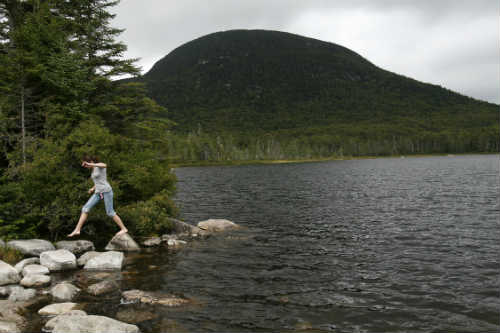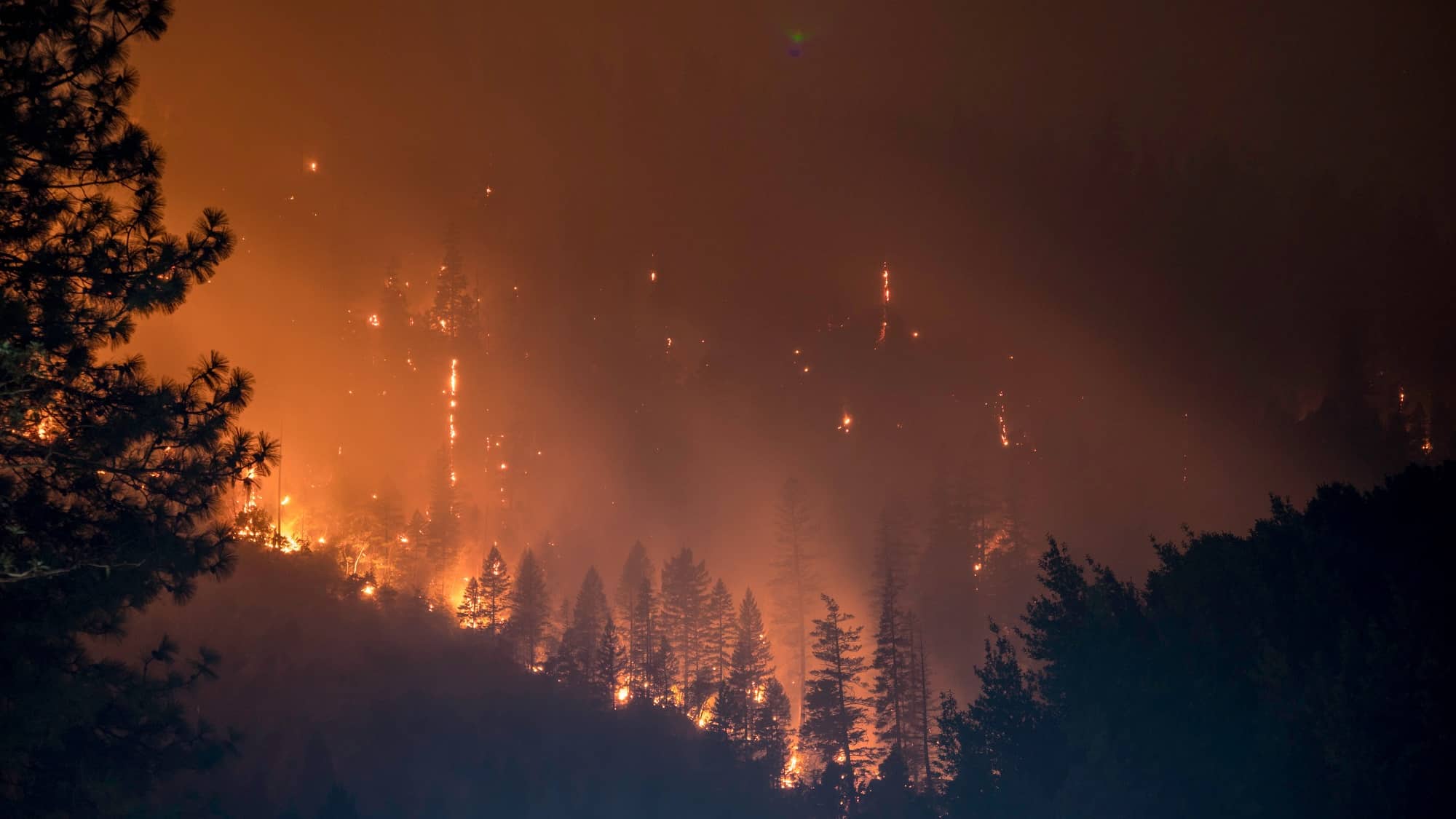Environmental Consequences of Forest Fires – A wildfire, and/or forest fire, is defined as being an uncontrolled fire that occurs in the wilderness.
They can be massive in size and have the ability to spread across vast distances, jumping rivers, roads and fire breaks in the process.
Usually, wildfires occur in hot and dry climates during the hottest months of spring and summer.
On average, there are a reported 60,000 to 80,000 wildfires each year, and 3 million to 10 millions acres of green land are destroyed in their wake.
Forest fire and Wildfires can have different effects on the environment depending on their size and frequency.

Environmental Consequences of Forest Fires
Have you noticed the apparent increase in wildfires across the globe?
If you’ve been paying attention, then you’ve already noticed the chatter surrounding climate change and global warming.
Raising temperatures continue to increase the likelihood of fires breaking out.
Have you stopped to consider what the environmental consequences of forest fires are?
Find out the top five ways wildfires impact the environment below.
Related Content: Consequences of Global Warming, potential dangers it brings to nature!
How does fire affect the environment
The most obvious environmental impact of a forest fire is the immediate loss of life and vegetation in the area.
As a fire breaks out, it spreads by burning through vegetation.
Wildfires take out smaller trees and ground-level vegetation first.
Depending on the size of the blaze, animals and humans may get trapped and killed.
First Responders attempting to put out the flames may also lose their lives.
The loss of vegetation and life causes both short-term and long-term effects on the environment.
Bigger trees typically survive smaller fires, but they do suffer long-term effects from their burn wounds.
Burns make bigger trees more vulnerable to insects, disease and funguses long after the initial threat passes.
Post Fire Erosion and Runoff
After the fire is put out, the initial threat is over.
Despite that, there are more environmental consequences of forest fires to consider.
What happens to all the ash, soot and debris that collects on the ground?
The scorched ground recovers by halting water absorption.
This tactic prevents the soil from absorbing debris.
Instead, the debris stays on the surface until it’s washed away by rain.
This effect is called post-fire runoff.
If runoff isn’t contained, then toxic sludge can make its way to natural water sources.
Water sources get contaminated:
• Active burning can cause ashes to get into the water supply
• Changes in the long-term chemistry of the water
• Cloudiness and increased presence of metals, dissolved organic carbon and sediment
• Potential chemical runoff
• Death and disease in local wildlife
Around 80 percent of freshwater sources in the United States come from forested land, so post-fire runoff should be concerning for all of us.
Polluted Air
A wildfire immediately produces a smoke cloud.
The polluted plume moves downwind and impacts everything in its path.
Animals and humans both suffer when they’re exposed to soot and smoke particles in the air.
On top of the smoke itself, fires often release other hazards into the air.
What types of pollutants and chemicals are commonly released during wildfires?
Pollutants and chemicals from forest fires
-
- Metals
- Particulates
- PAHs (Polycyclic aromatic hydrocarbons)
- Aerosols
- Nitrogen oxide
- Sulfur oxide
- Carbon dioxide
- An immediate loss of shelter
- Changes in the food supply
It may come as a surprise, but many animals benefit from fires.
Deer, turkey and other animals have more open area to graze.
Predator birds immediately benefit by preying on fleeing animals.
In some cases, wild bird species have been known to intentionally spread fires for this reason.
On the other hand, birds, reptiles and some smaller mammals often lose their nesting areas.
Fish and aquatic wildlife are also adversely impacted by runoff.
According to wildlife experts, young and smaller animals are the most vulnerable to both the short and long-term effects of fires.
Is fire good for the environment
After a forest fire there is a gentle rebirth.
Officials estimate over 3,000 human lives are lost each year as a result of fires throughout the country.
An additional $11.5 billion worth of property is damaged.
It’s impossible to measure the number of animals and level of vegetation that’s destroyed by fire.
These discouraging statistics highlight the negative aspects of fires, but there is light and hope on the other side.
After a blaze, nature always recovers and heals.
This process begins as grass and vegetation begin repopulating the burnt area.

Environment benefits of a forest fire
-
- All pest infestations are destroyed
- Prior diseases and fungal growths are killed
- The soil is replenished with carbons and nitrogen, making the area more fertile
- New growth is stronger and more resilient
While humans cause most modern-day fires, fires do occur naturally in nature as a result of lightning strikes and other causes.
These periodic burns are nature’s way of purifying the area.
Natural Vs Man-made Causes of Wildfires
Naturally occurring wildfires are far less frequent than man-made ones.
The most frequent causes of natural wildfires are volcanoes, lightning, spontaneous combustion, and sparks caused by rock slides.
Natural coal seam fires have also been attributed to causing wildfires when combustible plant material is located nearby.
Most commonly, wildfires are started by human negligence.
Intentional arson, equipment sparks, discarded cigarettes, unattended campfires, controlled agricultural burns and power lines have all caused a number of wildfires in the past.
With an increase in deforestation across the globe, highly flammable grasslands have taken their place.
Statistically speaking, six times as many wildfires are started by humans than any natural causes.
Whether caused by human negligence or naturally occurring, wildfires can be dangerous to homes and businesses in the surrounding areas.
In order to protect one’s self and home, evacuation plans should be set and home insurance should be purchased.
Classes and instruction can be found to help protect businesses and employees such as safety degrees online or by contacting a local fire department.
Environmental Consequences of Forest Fires – Positive Consequences of Wildfires
Wildfires can serve to clean up any dead or decaying matter strewn across forest, which, in turn, enables an increase in new plant growth.
Wildfires are also useful in maintaining the balance within an ecosystem by removing any harmful insects and diseased plants.
An added benefit of plant removal is an increase in sunlight, which can assist in the regeneration of plant seeds.
Scientists have also realized that wildfires can increase the amount of plant and animal diversity within a particular ecosystem.
In the midst of a wildfire, exceptional amount of nutrients are released into the soil, which can result in a flood of new plant growth.
Some plants even require wildfires to germinate their seeds and stimulate growth, such as the peculiar species of Panderosa pine trees.
Land use climate change adaptation and indigenous peoples
Regular wildfires also help by killing invasive species, allowing for indigenous species to continue thriving.
If wildfires do not occur regularly, this can lead to forested regions being overrun with underbrush and trees.
Subsequently, when these forests are finally subject to a wildfire, they may burn too hot, thereby stifling new growth rather than causing it.

Environmental Consequences of Forest Fires – Negative Consequences of Wildfires
When the frequency of wildfires in a particular region is too much, it may have a devastating impact on the ecosystem.
For example, frequent wildfires will disrupt the natural cycles of these forests by eradicating native plant species and encouraging growth of fire-resistant plants and other invasive plant species.
Because some of these invasive species are highly flammable, they cause a perpetual cycle where they increase the risk of future wildfires that further destroy native plant species.
Wildfires can exacerbate levels of carbon dioxide in the atmosphere, thereby strengthening the greenhouse effect that is already plaguing our earth.
Further, wildfires generate ash and destroy available plant nutrients, thereby greatly effecting the biodiversity of forests.
With an increase in water runoff, wildfires can engender flash flood conditions and enable soil erosion.
In conclusion, wildfires serve many purposes in nature, but whether they are positive or negative is contingent on their frequency and cause.
If human beings are striving towards a sustainable future, then a few precautionary measures must be made.
In regards to wildfires, humans need to become aware and educated of the potential consequences of their negligence.
If they can learn to live in symbiosis with the earth, then we can depend on the earth to provide us a sustainable future.

The Environmental Impact of Australia’s Fires
In October, Australia’s bushfire season officially began, but no one could have predicted what would transpire just months into the season.
As of January 10th 2020, New South Wales is still on an SOS alert as wildfires continue to ravish the continent.
Nearly one-third of Australia’s landmass has been scarred or currently has active fires raging.
Communities around the world are very concerned about Australia’s citizens and their wildlife.
They’re also wondering – what will the environmental impact of Australia’s fires be overall?
What caused this enormous tragedy, and how can we prevent it from happening again?

Learn everything you need to know about the devastating Australian bush fires and the environmental impact below.
The Immediate Environmental Consequences of Australia’s Fires
According to NBC News, wildfires are not new to Australia.
This particular season, though, is unlike anything experts have ever seen before.
It all started back in September of 2019.
From September to November, Australia experienced the driest spring in history.
Now, over 12 million acres have been completely destroyed by the worst bush fire season on record.
The bush-fire season hasn’t even reached its peak, either.
Experts expect the blazes to continue to plague the continent for months to come.
The immediate environmental consequences of these bush-fires include a significant loss of life, a change in the area’s weather and a serious need for Australians to re-evaluate their prior way of life.
Learn more about each of these topics below.
How Australia’s Fires Will Impact Human and Wildlife in the Area
While the fires are still raging, experts have already made initial estimates about the loss of life in Australia.
According to Vox, 27 Aussies have perished as a direct result of the fires.
Over 2,000 family homes have been burnt, and as many as one billion animals have died.
More wildlife is expected to perish as a result of relocation, though.
Environmental experts believe that these extreme wildfires will debilitate the area’s ecosystems.
Australian animals have adapted to Australia’s bushfire season, but it’s different this time.
They’ll have to regenerate in a totally scarred and destroyed area.
Experts are worried about this because about 244 mammal species are exclusive to Australia.
The continent is considered one of the biggest hotspots for diversity, but these extreme wildfires are threatening that.
The natural environment that so many animals rely on is slowly being destroyed.
As if that wasn’t enough, the air quality in Australia right now is threatening both human and animal life.
Currently, breathing the air in Sydney is as bad for you as smoking 37 cigarettes. T
here’s little doubt that this fact will cause significant health effects in the future.
Australia Bushfires: An Environmental Feedback Loop
As we touched on above, Australia’s bushfire season is the worst one in recorded history.
The wildfires are so extreme that they’re starting to create their very own weather.
Scientists are calling this effect an environmental feedback loop.
Here’s how it’s happening:
-
- As a fire burns, intense heat rises
- A smoke plume rises into the air and begins to cool
- The cooling smoke plumes create pyrocumulonimbus clouds (fire clouds)
- As a result of the fire clouds and moisture, a thunderstorm is produced
- The thunderstorm produces a downpour
- Lighting strikes occur
This environmental feedback loop is extremely concerning.
More thunderstorms mean more lighting.
More lighting means more fires.
On top of that, Australian citizens have experienced ‘firenadoes’ on several occasions.
These fire tornadoes appear suddenly, and they can be very dangerous.
They form when a fire-charged cloud formation collapses.
CNBC News reports that these fire-fueled smoke plumes can travel at speeds well over 100 mph.
According to witnesses, one of these firenadoes swept up a 10-12 ton firetruck.
In short, experts say this extreme bushfire is causing even more extreme weather events across Australia.
Australian Fires: Current and Future Pollution
Communities in Australia need to be informed about the ecological impacts of the fires on drinking water.
Currently, rainwater is polluted with fire-debris.
This rainwater will inevitably make its way into freshwater sources.
This polluted rainwater will harm not only wildlife in the area, but it can also impact humans who consume the water as well.
Drinking water supply centers often find increased levels of sediment, organic carbon and other chemicals after a fire.
In addition, ash and burnt vegetation can result in algae blooms.
It can take years for a freshwater source to become drinkable again.
On top of the water, air quality is a major concern.
Smoke exposure has devastating effects on humans and wildlife.
It often includes respiratory symptoms, infections and inflammation.
If you are in Australia, then it’s important to limit your time outdoors.
You also need to keep your home’s doors and windows closed.
If you own a particle filtration system, then you need to utilize it now.
Typically, air pollution after a wildfire is geographically limited.
According to the Washington Post, Australia’s bushfire pollutants are so massive that they’ll travel the entire globe before dispersing completely.
Smoke is being reported as far away as South America.
The smoke, according to experts, has penetrated the stratosphere, which means they’ll be sticking around for several weeks.
Looking to the Future: What Will The Impact Be?
It’s a terrifying scene – nearly 4,000 individuals were forced to gather together on the beach in Mallacoota, Victoria as massive flames engulfed the landscape.
Videos of the ordeal show how citizens were completely trapped.
Other communities throughout Australia are still isolated.
They can only be reached by air or sea, and often, the bushfire and smoke prevent any contact at all.
It remains unclear how this devastating bushfire season will impact the ecological future of Australia.
Thousands of individuals and billions of animals have lost their homes.
Yet, the fires continue to rage on.
Are you wondering how you can help?
Consider donating to a reputable Australian disaster relief fund.
You can also purchase items from Australia’s businesses online to help support their communities.
Common link between the massive Australia’s Fires and California Wildfires of Western United States
Australia is basically a dry place with a great many droughts.
If you look at Australia’s temperature and drought history you will see there was more droughts, high temperatures and much more bush fires 50 to 100 years ago vs than is recent decades.
But they not near as big massive wildfires that they are today.
Why?
The wildfires of 2019 – 2020, are very bad but not the worst.
They are not caused by global worming or by climate change.
They are caused by: HUMAN DECISION
Human decisions and government policies giving in to environmental pressures from Radical Green Preservationist and ultra environmentalist to stop taking the measures historically done (and needed) to clear land with prescribed burns to provide relief from these types of wildfires.
Wildfire Preventative measures
The fires in California, Western United States and Australia are caused by human decisions driven and based upon environmentalist pressures from ultra green radical preservationist groups blocking the needed and effective preventative measures.
Western United States Stopped timber production in national forests due to green groups pressuring federal agencies, state governments and US Congress.
What the World needed to do is ‘Get Woke’ and not listen to these ultra radical environmental preservationists and start listening to the experts and people who know that we need to start managing our natural areas and about managing our national resources.
And in Western United States in particular, to start producing lumber again.
